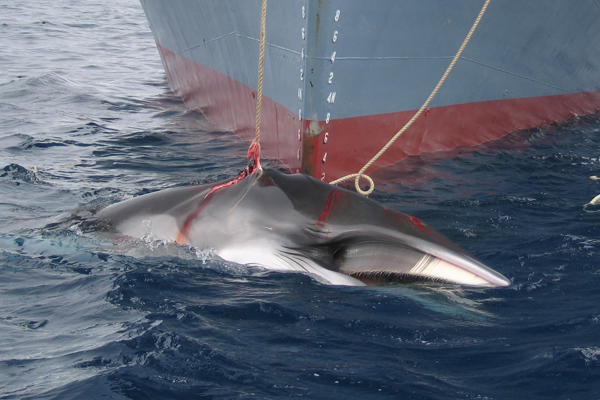Wildlife protection : Leveraging the EU-Japan trade deal

EurActiv | 31 January 2017
Wildlife protection : Leveraging the EU-Japan trade deal
By Joanna Swabe
Dr Joanna Swabe is Executive Director for Humane Society International/Europe.
The EU-Japan trade deal is an opportunity to encourage Japan to stop flouting multilateral environmental agreements, writes Joanna Swabe.
Free trade agreements, if drafted appropriately and resourced adequately, can potentially offer a platform to influence positive change for the lives of animals, particularly wildlife. Indeed, they provide an opportunity for parties to work cooperatively to achieve common goals, with formal channels to initiate discussion, share best practices, and form and execute action plans subject to public input and scrutiny.
The recently concluded EU-Vietnam free trade agreement is perhaps the best developed EU trade deal so far with respect to provisions for wildlife protection. Rather than having just a boilerplate commitment in sustainable development chapters on the proper implementation and enforcement of multilateral environmental agreements, it also includes provisions aiming to protect biodiversity and reduce illegal wildlife trade through information exchange on strategies, policy initiatives, programmes, action plans and consumer awareness campaigns. The agreement even includes an explicit commitment to enhance cooperation to increase species protection through proposing new listings on the Convention on International Trade in Endangered Species of Wild Fauna and Flora (CITES) appendices.
Although the Transatlantic Trade and Investment Partnership (TTIP) may well be dead in the water after Trump’s election, it is undeniable that the European Commission’s wildlife protection ambitions for this trade deal were loftier still, as their published proposals for a Sustainable Development chapter evidenced.
Yet, in contrast to the EU-Vietnam and proposed EU-US trade deals, the prospect of a meaningful outcome for wildlife protection through the EU-Japan FTA, which concluded its 17th negotiation round in September 2016, are very bleak.
Certainly Japan’s response to species protection decisions taken at the recent CITES Conference of Parties meeting in Johannesburg, suggests that even a bog-standard commitment to multilateral environmental agreements in this trade deal could prove to be completely hollow.
Japan’s track record on protecting wildlife has not exactly been stellar. For many years, Japan has flouted the International Whaling Commission moratorium on commercial whaling by issuing special permits for so-called ‘scientific’ whaling and killing hundreds of whales each year. It also recently ignored an International Court of Justice ruling striking down its whaling programme as not scientific, even going so far as to reject any future jurisdiction of the ICJ over all disputes involving marine living resources, including whales.
Calls for the Commission to address the whaling issue through the EU-Japan FTA have thus far fallen on deaf ears.
With respect to CITES, when the Parties voted to strictly regulate the trade in Oceanic whitetip, porbeagle and hammerhead sharks through an Appendix II listing in 2013, Japan took out a reservation, thereby declaring itself not bound by the provisions of the Convention as regards these species. In October 2016, CITES parties voted in favour of including additional vulnerable shark species, silky and thresher sharks, in Appendix II. Once again, during the debate, Japan predictably voiced its intention to take a reservation on these species. These were not hollow threats. In December 2016, Japan did indeed enter its reservation, exempting itself from affording any additional protections to these shark species.
Equally alarming was Japan’s response to the debate surrounding the adoption of a CITES resolution recommending the closure of domestic elephant ivory markets contributing to poaching or illegal trade. On 30th September 2016, Japan’s Minister of Environment Yamamoto stated that the Japanese market does not comprise poached ivory. Contrary to this statement, there is evidence of the laundering of ivory of dubious origins in Japan’s domestic market, plus recorded instances of more than 3.2 tonnes of ivory smuggled from Japan to China from 2010 to 2012. It is naïve to think that Japan’s ivory market exists in a vacuum.
With the European Commission having recently made a strong commitment to tackling illegal wildlife trade through its ambitious EU Action Plan against Wildlife Trafficking, which includes a pledge to use trade policy as an instrument to do so, it would behove them to get tough on wildlife protection in their trade negotiations with Japan to – at the very least – stop them from making a mockery of the multilateral environmental agreements to which they are a signatory.
Finally, to guarantee the enforceability of commitments made in any EU-Japan trade deal – and indeed all future FTAs – the Commission should also introduce a binding dispute settlement mechanism for its Sustainable Development chapter. Such a mechanism would truly allow Japan to be held accountable for its commitments to wildlife protection in the context of the trade agreement.





